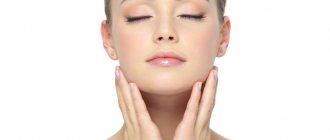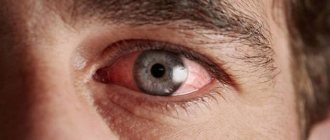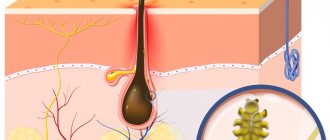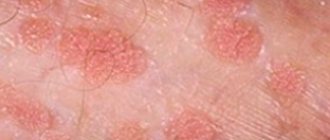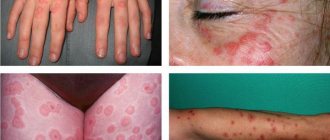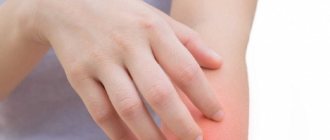General information
Dermatoses in adults are represented by a wide group of heterogeneous diseases of the skin/its appendages of different origins (allergic, infectious, immune, hereditary, dystrophic, etc.), caused by external/internal causes or combined etiological factors.
In fact, “dermatosis” is a collective term denoting various acquired/congenital pathological conditions of the skin and skin appendages. At the same time, this term includes both group concepts (“dermatitis”, “dermatozoonoses”, “pyoderma”, “toxicoderma”, “mycoses”, “photodermatoses”, “keratoses”, “psychogenic skin diseases”, etc.) and individual nosological forms. About 2 thousand dermatoses are presented in the literature, and often variants of the clinical course of one dermatosis have independent names. In the structure of dermatoses in adults, the most common are atopic dermatitis , allergic dermatitis , eczema , psoriasis , pyoderma , urticaria , vitiligo , acne conglobata , seborrheic dermatitis , neurodermatitis , furunculosis , keratosis pilaris , ichthyosis , alopecia areata , palmoplantar keratoses derma , scabies , mycoses (microsporia, trichophytosis, mycoses of the feet), viral dermatoses (herpes simplex/shingles). Relatively rare dermatoses include elastosis ( skin atrophy ) and, in particular, solar elastosis, which is accelerated degenerative changes in the connective tissue of the skin (collagen/elastic fibers) that develop under the influence of ultraviolet rays (skin photoaging). Occupational dermatoses are also relatively rare.
Data on the prevalence of certain dermatoses among the population, gender indicators, and the proportion of specific nosological forms vary over an extremely wide range.
Over the past decade, there has been an increase in the proportion of clinical chronic dermatoses, forms with a severe/recurrent course, resistant to standard methods of therapy, which contributes to a prolongation of the period of disability and an increase in cases of disability. The chronic course of the vast majority of chronic dermatoses causes psychosocial maladaptation in patients of varying degrees of severity, leading to a decrease in quality of life. Moreover, in many patients with chronic dermatoses, the lack of remission and the presence of constant irritation in the form of disturbing itching forms an additional pathogenic complex, leading to a disturbance in the psycho-emotional state and exhaustion of the nervous system. Let us briefly consider only some groups of dermatoses.
Infectious dermatoses . Patients with skin infections constitute the largest group of dermatological patients. The causative agents of infectious dermatoses may include viruses, bacteria, and fungi. A common feature of skin infections is the important role of the state of the immune system, which largely determines their course. Infectious dermatoses include pyoderma , hidradenitis , vesiculopustulosis , epidemic pemphigus of newborns , streptococcal impetigo , cellulitis , paronychia , erysipelas , boils , etc.
Pruritic dermatoses are a group of skin diseases caused by primary, severe universal/limited skin itching and scratching (excoriation), to which the skin responds with the development of lichenification/lichenoid papules. In most cases, itchy dermatosis is a manifestation of an allergic reaction to allergens, which can be a variety of factors (animals, cosmetics, food/plant allergens, stress, etc.). Often this group of diseases is called allergic dermatosis (allergic dermatosis), since allergic dermatosis develops with repeated contact with an allergen to which the patient is hypersensitive. The most common pruritic dermatoses include atopic dermatitis , psoriasis , prurigo , chronic urticaria , neurodermatitis , pityriasis rosea , allergic contact dermatitis , eczema , scabies , seborrheic dermatitis , etc.
Bullous dermatoses (syn. blistering dermatoses) are represented by a group of skin diseases of non-infectious origin, differing in etiopathogenesis, clinical course and pathohistological changes. For bullous dermatitis, a characteristic feature is the formation of monomorphic rashes in the form of blisters or combined with a polymorphic rash. Bullous dermatoses are represented by such nosological forms as impetigo , true pemphigus , burns , bullous zpidermolysis , contact dermatitis , reactions to insect bites , benign chronic familial pemphigus , pemphigoids , dermatosis herpetiformis , bullous drug rash , autoimmune pemphigus , etc. Bullous dermatoses oses are characterized by a severe course, and in some of them, in the absence of adequate treatment, there is a high risk of death.
Diagnostics
If symptoms of a skin disease appear, you should make an appointment with a dermatologist. During the consultation, the doctor will ask the patient about complaints and collect medical history information to identify risk factors for dermatosis. Then a general examination of the skin is performed to identify characteristic clinical signs of pathology. To clarify the diagnosis, the dermatologist needs the results of instrumental and laboratory tests.
Additional diagnostics:
- Laboratory blood tests. In the treatment room, a nurse collects venous blood and sends the material to the laboratory. Specialists evaluate the ratio and quantity of formed components, and also study the biochemical parameters of the blood. A blood test can detect signs of infection, autoimmune inflammation or other pathology.
- Dermatoscopy. Using a special device, the doctor takes an enlarged photo of the affected area of skin and studies the features of the rash. Dermatoscopy is important for differential diagnosis and exclusion of dangerous diseases such as melanoma.
- Laboratory examination of exudate. The specialist collects secretions from ulcers or other skin formations. The resulting material is studied in the laboratory to detect pathogenic microorganisms or signs of inflammation.
- Histological examination of the skin. A biopsy is performed if it is necessary to exclude oncology.
- Carrying out allergy tests. The doctor places microscopic particles of the irritant on the skin and monitors the condition of the tissue. This study is necessary to find the source of the allergy.
If necessary, the dermatologist may prescribe additional tests, including a general urine test. A timely appointment with a doctor helps to quickly clarify the cause of the rash and select effective treatment.
Pathogenesis
The pathogenesis of dermatoses varies extremely depending on the group of dermatoses and nosological forms, and it is not possible to describe them within the scope of the article. It should only be pointed out that a significant role in the development of dermatoses is played by an allergic reaction of immediate/delayed type, autoimmune disorders, toxic damage to the skin, violation of the integrity of the skin, infection of the skin/metastasis of an infectious agent into it, degenerative changes in collagen/elastic fibers of the skin, neurogenic mechanisms, etc. .
Treatment methods
Polymorphic skin formations, characteristic of certain types of dermatosis, arise for various reasons, so treatment is selected after diagnosis. Most often, a dermatologist prescribes drug therapy. The dermatologist takes into account possible contraindications before selecting therapy.
Frequently prescribed drugs:
- Corticosteroids are medications that ease the inflammatory response.
- Antibiotics are drugs that destroy pathogenic microorganisms.
- Antiseptics for external use.
- Antihistamines are medications that prevent the development of an allergic reaction and skin lesions.
- Various immunosuppressants that suppress autoimmune reactions.
The listed medications can be prescribed in the form of ointments, gels, tablets or solutions for intravenous administration. Local use of corticosteroids can reduce the risk of side effects. Additional treatment options include surgery and physical therapy. In most cases, the dermatologist prescribes a hypoallergenic diet and vitamin supplements to the patient. Compliance with the doctor’s recommendations helps prevent the development of relapse.
Classification
Several classifications of dermatoses have been proposed, based on various characteristics. Below is a simplified version of the classification of dermatoses, according to which they are distinguished:
- Itchy dermatoses - atopic dermatitis , psoriasis , prurigo , chronic urticaria , neurodermatitis , pityriasis rosea , allergic contact dermatitis , eczema , scabies , seborrheic dermatitis , etc.
- Bullous dermatoses - true pemphigus (vegetative, erythematous, vulgaris, foliate, Brazilian), pemphigoid (bullous, recurrent), dermatoses herpetiformis (herpes of pregnancy, Dühring's dermatosis herpetiformis.
- Allergic dermatoses - atopic, toxic-allergic, contact dermatitis , erythema .
- Infectious dermatoses (bacterial, viral, fungal) - pyoderma , hidradenitis , vesiculopustulosis , epidemic pemphigus of newborns, streptococcal impetigo , paronychia , erysipelas , mycoses , etc.
- Parasitic dermatoses - caused by parasitic insects (scabies, leishmaniasis, cysticercosis).
- Occupational dermatoses - skin pathologies caused by contact with various irritating, allergenic and industrial environmental factors (fiberglass, dust, acids, alkalis) - toxicoderma , epidermoses , folliculitis , dermatitis , eczematous manifestations , vasculitis , porphyria , melasma , vitiligo , lichen , occupational eczema , paronychia , onychia , burns , photodermatoses , urticarial rashes , Quincke's edema , dermatoconiosis , etc.
Treatment of herpetic dermatitis
The disease responds well to treatment if you start using antiviral ointments and alcohol tinctures at the first manifestations of symptoms, even before the formation of blisters. At this stage, you may notice slight redness on the lips and a feeling of itching. The drugs acyclovir and zovirax are effective and should be applied to the affected areas 6-7 times a day.
Recurrent viral dermatosis is more difficult to treat. To prevent it, vaccination is done.
Causes
Dermatoses are based on polyetiological factors that act as triggers of pathological processes of the skin/skin appendages, which are conventionally divided into 2 groups: internal (endogenous) and external (exogenous).
The group of endogenous factors includes:
- Hereditary predisposition/genetic defect.
- Local infection of various locations - in the nasopharynx (tonsils, maxillary sinuses, gallbladder/bile ducts, kidneys ( pyelonephritis ), etc.
- Chronic diseases of internal organs (liver, intestines, kidneys), which carry out processes of neutralization/removal of toxins from the body.
- Hypovitaminosis (A, groups B, C and P).
- Functional/organic circulatory disorders.
- Lymph circulation disorders.
- Functional/organic lesions of the peripheral (neurovegetative disorders) and central nervous system.
- Disorders of the function of the endocrine glands (thyroid gland, adrenal glands, gonads).
- Genetic defect, hereditary predisposition.
- Immunosuppressive conditions.
- Diseases of the hematopoietic system.
The group of exogenous factors includes:
Physical/chemical/biological exposure factors, environmental factors (mechanical irritants, low/high temperature, electric current, ionizing radiation, ultraviolet rays, food products, chemicals, drugs, infectious agents, etc.).
As a rule, the development of dermatosis is caused by a combination of several factors: the action of a trigger, a decrease in local skin protection, insufficient immune response to the influence of an aggressive factor, etc. In some cases, even an isolated impact (burn/frostbite) can provoke a skin disease.
Symptoms
Symptoms of dermatosis depend on the group of dermatoses and the specific nosological form, and it is not possible to give an exhaustive description of them within one article. The general symptom of most dermatoses is the presence of primary/secondary various morphological elements of the rash - spot, papule, tubercle, node, vesicle, bubble, pustule, blister, excoriation, crack, scales, crust, ulcer, scar, pseudoleukoderma (discolored spots on the skin in the area localization of resolved rashes). At the same time, certain nosological forms are characterized by the same type of rash, and for some there is their diversity or staged polymorphism. Also, a number of dermatoses are characterized by the specific localization of rash elements, the number of rash elements (multiple/single), the time period of their appearance, the uniformity of distribution, the simultaneous appearance or spread over time, the merging of rash elements, and the background of the skin.
Symptoms of dermatosis often manifest themselves as itching (pruritic dermatoses), against which secondary foci of infection appear due to scratching and colonization by various pathogenic/opportunistic microflora. In this case, bacteria/fungi can act as triggers that provoke exacerbation of chronic dermatoses. In addition to local manifestations, a number of dermatoses may also cause the general condition of the patient to suffer (low-grade fever, headaches, general malaise), and there may be changes in the lymphatic system and blood.
Allergic dermatoses are one of the groups of dermatoses often encountered in medical practice, the representatives of which include atopic dermatitis , eczema , contact dermatitis , neurodermatitis , and urticaria . The clinical picture of dermatoses in this group is characterized by significant severity of inflammatory changes in the skin. Thus, allergic dermatosis manifests itself with various types of allergic rashes (erythematous, vesicular/papular elements) on the skin of almost any part of the body. Elements of the rash usually develop against the background of erythema and are accompanied by a feeling of heat, burning and disturbing itching. An allergic rash is characterized by a weakly expressed polymorphism of rashes (scales, erosions, vesicles, papules, crusts), and directly in the affected areas there is swelling, bright hyperemia, weeping and the formation of scales-crusts/crusts in the future. With this pathology, acute inflammatory changes in the skin develop suddenly and increase in intensity extremely quickly, causing physical/psychological discomfort (photo below).
Allergic dermatitis completely/quickly regresses after eliminating contact with the allergen. At the same time, the risk of relapse of allergic contact dermatitis upon repeated contact with the allergen is quite high and develops quickly.
Blistering dermatoses are characterized by an undulating chronic course. Let us consider only the symptoms of true pemphigus vulgaris, which is characterized by monomorphism of rashes, the appearance on visually unchanged skin/mucous membranes of the nasal/oropharynx, genitals, red border of the lips of various sizes of intraepidermal blisters with serous contents (Fig. below).
Patients experience pain when swallowing saliva, eating and talking. A characteristic sign is the appearance of a specific odor from the mouth and drooling ( hypersalivation ). As a rule, the mucous membrane is initially affected, and later (after 3-6 months) the process spreads to the skin. At the same time, the appearance of blisters on the mucous membranes often goes unnoticed due to their rapid opening, and in their place painful, long-term non-healing erosions form. Blisters on the skin also persist for a short time, and some of them may shrink into crusts. Characteristic is Nikolsky's symptom , manifested by the separation of layers of the epidermis with minor mechanical impact. With vulgar pemphigus , erosions with a shiny, moist surface of a bright pink color, and their feature is a tendency to peripheral growth and the risk of the formation of extensive lesions (generalization of the skin process) with the addition of a secondary infection, deterioration of the general condition, the development of intoxication and, if left untreated, fatal outcome. pseudoleukoderma often develops . In general, bullous dermatitis is characterized by a severe course.
general information
Dermatosis is the name of congenital and acquired skin diseases, manifested by rash, redness of the skin, burning and other symptoms.
In most cases, we are talking about inflammatory pathologies caused by allergic reactions or infections. Dermatoses can be associated with dangerous conditions of the nervous and endocrine systems. At the same time, nails and hair are also exposed to pathological effects. Almost every person has experienced at least one form of dermatosis during their lifetime. This may be a temporary irritation of the skin when exposed to an allergen or a severe chronic condition. Inflammatory skin diseases are more common among women. Some types of dermatosis, such as psoriasis, are difficult to treat, but modern means can successfully eliminate the most unpleasant symptoms of such ailments.
During pregnancy
Dermatoses of pregnancy are represented by a group of specific skin diseases ( atopic eruptions of pregnancy , pemphigoid of pregnancy , polymorphic dermatosis of pregnancy and intrahepatic cholestasis of pregnancy ), which arise during gestation and resolve spontaneously after childbirth.
Let's consider polymorphic dermatosis of pregnancy, which is a self-limiting benign inflammatory disease of the skin, which is characterized by intense itching and a polymorphic rash (urticarial papules/plaques, small vesicles). The incidence rate varies between 0.45-1.0%. At the same time, about 40% of cases occur in first-time women, 30% of cases - in women with a second pregnancy, and 15% of cases - in women with a third pregnancy. Polymorphic dermatosis in most cases occurs in the 3rd trimester of pregnancy, the incidence of the disease in the 1st and 2nd trimester is significantly lower, and in the postpartum period polymorphic dermatosis is extremely rare.
Primary rashes are located mainly on the skin of the abdomen, often on the surface of “stretch marks” (stretch marks). At the same time, the skin of the peri-umbilical area is not affected. Less commonly, rashes spread to the breasts, lower back, buttocks, thighs and upper limbs. Damage to the mucous membranes/skin of the scalp, face, palms, and soles is uncharacteristic. Subsequently, the primary elements evolve into scales/crusts, and later into unstable hypopigmented spots. There is no scarring process (photo below).
The duration of the rash varies between 3-6 weeks, and its maximum severity is observed in the first week of the rash. Itching is moderate to severe, with virtually no excoriation. As a rule, the rash resolves on its own, and there are no associated complications for the fetus and the woman. Children do not develop rashes after birth.
Treatment is carried out by prescribing topical steroid drugs of groups II-V ( Laticort , Flucinar , Lorinden , Oxycort ), antipruritic lotions (Calamine lotion "Sarna") and cool compresses.
Treatment of dermatoses
Treatment of dermatoses should be both general and local. Medicines used externally mainly have a symptomatic effect: anti-inflammatory, antipruritic, stimulating regenerative processes, antifungal and antibacterial. All kinds of creams , ointments, patches, lotions and solutions will help you correctly calculate the dosage, affecting deeper skin lesions. To treat dermatoses, drugs are widely used that can cause the fusion of skin cells, thereby starting the regeneration process. It is possible to treat dermatoses with physiotherapy, diet therapy, or placement in a sanatorium-resort setting.
Manifestations of dermatosis are always accompanied by inflammatory processes. Antifungal, antiviral and antibacterial measures to prevent dermatosis are also prescribed. The recovery and cleansing of the skin is accelerated.
Diet
Hypoallergenic diet
- Efficacy: therapeutic effect after 21-40 days
- Timing: constantly
- Cost of products: 1300-1400 rubles. in Week
Diet for skin diseases
- Efficacy: therapeutic effect after a month
- Time frame: three months or more
- Cost of products: 1400-1500 rubles per week
Diet for dermatitis
- Efficacy: Therapeutic effect after 3 weeks
- Timing: Constantly
- Cost of products: 1300-1390 rubles per week
Diet for psoriasis
- Efficacy: healing effect
- Timing: constantly
- Cost of products: 980-1150 rubles per week
In the complex therapy of dermatoses, rational dietary nutrition is the most important method of treatment. This primarily applies to allergic/pruritic dermatoses, but is also important for dermatoses of other groups. For this purpose, Diet for Dermatitis , Hypoallergenic Diet , Diet for Skin Diseases , Diet for Psoriasis , and so on may be prescribed.
Since almost any dermatosis has an allergic component, it is recommended to exclude from the diet foods that have a high sensitizing activity, contain histamine or contribute to its production (chocolate, cow's milk, strawberries, coffee, cocoa, orange juice, hard cheeses, smoked meats, tomatoes, hazelnuts , tuna, herring) and artificial food additives.
In case of atopic / seborrheic dermatitis, all easily digestible carbohydrates (jam, sugar, sweet pastries, preserves, confectionery, condensed milk, sweets, honey) are subject to restriction. Also excluded are smoked meats, sausages, seafood, rich broths, red meat, marinades/sauces, canned fish/meat, seasonings (mustard, horseradish, vinegar, ketchup, mayonnaise), pickled vegetables, mushrooms, spicy dishes, salt, sauces, animal fats. , sweet drinks and alcoholic drinks.
For a number of dermatoses, it is necessary to exclude specific groups/types of foods from the diet, for example, for bullous dermatoses ( Dühring's dermatitis herpetiformis ) - exclusion of foods containing glutin and iodine. A particularly strict diet should be followed for chronic recurrent dermatoses during exacerbation.
Prevention
There is no specific prevention. For each specific nosology, there are specific preventive measures, for example, for atopic dermatosis - avoidance of triggers (provoking factor) - contact/food allergens, aeroallergens; for mycoses - compliance with hygiene rules in the team/family, carrying out disinfection measures in public places (hotels, hairdressers, sports complexes, baths, dormitories); for infectious dermatoses - limit contact with persons who are carriers of skin diseases of infectious origin; for industrial dermatoses - use of personal protective equipment when in contact with aggressive substances at work, and so on.
Risk factors
In addition to the direct causes of pathology, doctors take into account the influence of additional factors related to heredity, lifestyle and the patient’s individual history.
Possible risk factors:
- Excessive ultraviolet exposure.
- Using personal hygiene products that are harmful to the skin.
- Insufficient skin hygiene.
- Genetic disorders (eg, epidermolysis bullosa.)
- Allergic history. If a person suffers from allergies, the risk of dermatosis increases.
- Diseases associated with a high risk of skin pathology: bronchial asthma, congestive heart failure, HIV infection.
- Professional activity that requires constant contact with chemicals and other irritants.
- Age. Inflammatory dermatoses occur more often in children and young patients.
- Hormonal changes in adolescents, pregnant women and other categories of patients.
Considering risk factors helps dermatologists prescribe preventative measures.
List of sources
- Kirichenko I.M. Modern approaches to the treatment of infectious skin diseases. Cons. Med. 2006; 8 (1): 8-10.
- Korotkiy N.G., Taganov A.L., Tikhomirov A.A. Modern external therapy of dermatoses (with elements of physiotherapy). Ed. N. G. Korotkoy. Tver: Provincial Medicine, 2001.
- Albanova V.I., Nefedova M.A. Acquired epidermolysis bullosa: difficulty of diagnosis. Bulletin of Dermatology and Venereology 2022, No. 2; With. 65-72.
- Clinical dermatovenerology. Guide for doctors in 2 volumes. Ed. Yu. K. Skripkina, Yu. S. Butova. M.: GEOTAR-Media, 2009. T. 1, 720 p. T. 2, 928 p.
- Federal clinical guidelines. Dermatovenereology 2015: Skin diseases. Sexually transmitted infections. — 5th ed., revised, and additional. - M.: Business Express, 2016. - 768 p.
